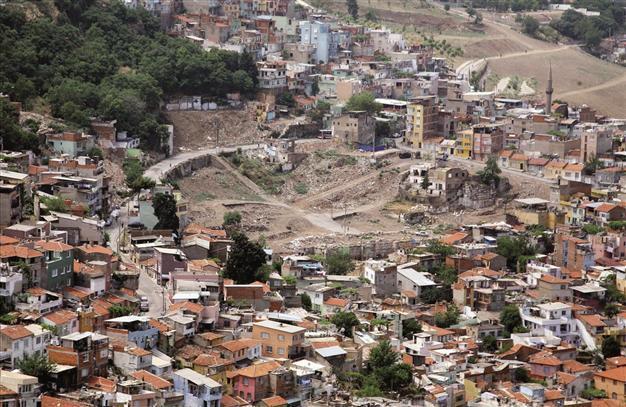Residents of impoverished İzmir neighborhood hit jackpot with ancient theater's discovery
İZMİR – Doğan News Agency

Parts of the stage walls of an ancient Roman theater were unearthed in İzmir’s Kadifekale neighborhood after rubble was cleared away from a site. DHA photo
Following the discovery of an ancient theater in İzmir’s Kadifekale district, the real estate prices in the surrounding areas have increased by up to 100 percent.The owners of a number of buildings in the area, including those certified as historical structures, have hung up “For Sale” signs, while other owners have chosen not to sell, anticipating that prices will increase further.
Parts of the stage walls of an ancient Roman theater were unearthed in Kadifekale after the rubble on a site was cleaned away.
The locals claim that the site attracted many visitors, including tourists, and that the existence of the theater is now widely known; it is the second biggest ancient theater in the world, and is becoming more and more famous every day.
A resident of one of the neighboring houses, Şerif Ali Saraç, said he was now the neighbor of a “grand treasure.”
“How many people in the world get the chance to live next to an ancient theater? Everybody in the area knows that their houses are going to increase in value, so they have decided not to sell their property yet. I was born and still live in a historical building, but how could I have known that there was such a treasure next to where I grew up? There has been a big increase in the real estate prices around the area. Some houses that were worth 60,000 to 70,000 Turkish Liras are now worth 150,000 to 200,000 liras,” Saraç said.
Other residents said there are also rumors about the existence of gold and historical artifacts below the neighboring houses, and some people have started to dig tunnels under their houses in the hope of finding treasure. Some residents also claim that they have seen photographs of such artifacts.
The most comprehensive information about the ancient theater in Kadifekale can be obtained from the plans and drawings of Austrian architects and archaeologists Otto Berg and Otto Walter, who conducted studies in the region in 1917 and 1918.
The remains of the theater, which is thought to have held a capacity of 16,000 people, has characteristics of the Roman era, according to many researchers, the study reports.
Ancient sources claim that Saint Polycarp from İzmir was killed in the theater during the early years of Christianity and the pagan period of the Roman era.
After the İzmir Municipality finishes work on restoring the theater, it will play host to shows and concerts, similar to the ancient theater of Ephesus, in İzmir’s Selçuk district.
















